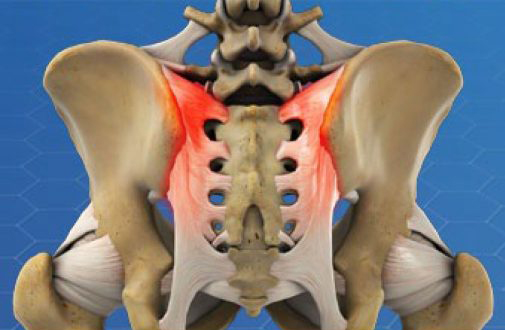If you experience a pain that starts on either side of your lower back and shoots down your buttocks and down the back of your thigh, you may be having sacroiliac joint pain. The sacroiliac joint is actually two joints that are found on either side of your spine. They connect the sacrum, which is the fused, lowest vertebrae in your spine to your pelvic bone.
What Does the Sacroiliac Joint Do?
The sacroiliac joint is not quite a joint in the traditional sense because it hardly moves. What it does is transfer the weight from your upper body into your legs. This lets you twist when your legs are moving, as it would when you’re playing football, skiing or enjoying some other sport where you have to twist your body. The joint can become painful through wear and tear, a fall, a kick to the buttocks or some kind of trauma to your pelvis. Inflammatory arthritis can cause pain in the sacroiliac joint, as can a condition called ankylosing spondylitis, or AS. Other causes are gout and pregnancy. Some people get sacroiliac joint pain because they were born with one leg just sightly shorter than the other.
More Symptoms of Sacroiliac Joint Pain
When your sacroiliac joint is inflamed, the pain you feel may be worse when you play a sport or exercise. It may hurt to roll over in bed and to sit for a long time. You may feel stiff when you walk or sit for a long time. The pain may spread to your groin, and you may feel numbness and weakness in the area. Some people feel that their legs may give way and not support their weight.
How It’s Diagnosed and Treated
The doctor will give you a physical examination and order X-rays or MRI scans to see if one or both of your sacroiliac joints are inflamed. They may prescribe anti-inflammatory drugs such as aspirin or ibuprofen for the pain. Other medications used to treat sacroiliac pain are muscle relaxants and corticosteroid injections directly into the inflamed joint. Some patients are given oral steroids, but only for a short time, while some doctors destroy the nerves in the area with radiofrequency ablation. A person with AS who also has sacroiliac pain may be given tumor necrosis factor inhibitors.
As with other conditions affecting the spine, doctors consider surgery to be the last resort when nothing else helps the pain of the inflamed sacroiliac joint. In this surgery, the bones of the sacroiliac joints are fused with the help of screws or plates. Fortunately, most cases of sacroiliac joint inflammation and pain can be healed with conservative treatments.
Part of the treatment is physical therapy that strengthens the muscles and makes your body more flexible. Other patients respond well to having the area strapped to take the load off of the joint, and others do well with soft tissue massage, electrotherapy and exercises that strengthen their core as we;; as the lower and upper limbs.
Make an Appointment today!

